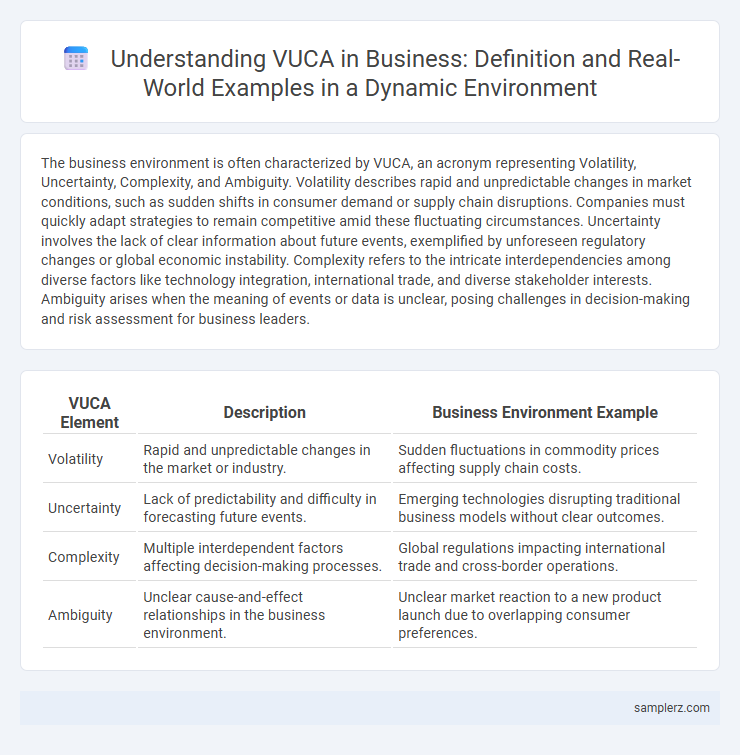The business environment is often characterized by VUCA, an acronym representing Volatility, Uncertainty, Complexity, and Ambiguity. Volatility describes rapid and unpredictable changes in market conditions, such as sudden shifts in consumer demand or supply chain disruptions. Companies must quickly adapt strategies to remain competitive amid these fluctuating circumstances. Uncertainty involves the lack of clear information about future events, exemplified by unforeseen regulatory changes or global economic instability. Complexity refers to the intricate interdependencies among diverse factors like technology integration, international trade, and diverse stakeholder interests. Ambiguity arises when the meaning of events or data is unclear, posing challenges in decision-making and risk assessment for business leaders.
Table of Comparison
| VUCA Element | Description | Business Environment Example |
|---|---|---|
| Volatility | Rapid and unpredictable changes in the market or industry. | Sudden fluctuations in commodity prices affecting supply chain costs. |
| Uncertainty | Lack of predictability and difficulty in forecasting future events. | Emerging technologies disrupting traditional business models without clear outcomes. |
| Complexity | Multiple interdependent factors affecting decision-making processes. | Global regulations impacting international trade and cross-border operations. |
| Ambiguity | Unclear cause-and-effect relationships in the business environment. | Unclear market reaction to a new product launch due to overlapping consumer preferences. |
Understanding VUCA: Defining its Relevance in Today's Business Environment
VUCA, an acronym for Volatility, Uncertainty, Complexity, and Ambiguity, encapsulates the dynamic challenges businesses face in today's environment. Rapid technological advancements and fluctuating global markets exemplify volatility, while regulatory changes introduce uncertainty, making strategic planning difficult. The intricate interdependencies in supply chains highlight complexity, and ambiguous consumer behavior demands agile decision-making to maintain competitive advantage.
Volatility in Environmental Regulations: Case Studies from the Energy Sector
Volatility in environmental regulations significantly impacts the energy sector, exemplified by sudden policy shifts such as the introduction and repeal of carbon pricing mechanisms in regions like California and Alberta. These abrupt changes create uncertainty for energy companies, influencing investment decisions, project timelines, and compliance strategies. Case studies from the sector reveal how firms adapt through flexible operations and diversified energy portfolios to mitigate the risks associated with regulatory unpredictability.
Managing Uncertainty: The Impact of Climate Change on Supply Chains
Climate change intensifies supply chain disruptions through extreme weather events, resource scarcity, and regulatory shifts, exemplifying VUCA's volatility and uncertainty. Businesses must adopt adaptive strategies like diversified sourcing and real-time data analytics to mitigate risks and maintain operational resilience. Proactive scenario planning enhances preparedness against unpredictable climate-driven impacts on global supply networks.
Complexity in Global Markets: Environmental Challenges for Multinational Corporations
Multinational corporations face significant complexity in global markets due to varying environmental regulations, diverse climate policies, and fluctuating resource availability across regions. Managing sustainable operations requires navigating intricate supply chains and adapting strategies to local ecological standards while maintaining global efficiency. This complexity intensifies with increased stakeholder demands for transparency and corporate social responsibility in environmental practices.
Navigating Ambiguity: Evolving Sustainability Standards in Business
Rapid changes in environmental regulations create ambiguity for businesses striving to meet evolving sustainability standards. Companies must interpret inconsistent guidelines while balancing economic goals and social responsibility amid uncertain legislative landscapes. Effective strategies involve adaptive compliance frameworks that anticipate shifting policies and stakeholder expectations.
Digital Transformation and VUCA: Environmental Data Management Case Examples
Digital transformation exemplifies VUCA (Volatility, Uncertainty, Complexity, Ambiguity) in environmental data management by enabling real-time analysis of fluctuating climate patterns and regulatory changes. Advanced AI algorithms process massive datasets from IoT sensors to predict environmental risks despite incomplete or ambiguous data inputs. Case examples like smart grid implementations and adaptive supply chain monitoring demonstrate how digital tools mitigate complexity and enhance decision-making in unpredictable ecological and regulatory landscapes.
Risk Mitigation Tactics: Business Continuity in a VUCA Environmental Landscape
Unexpected supply chain disruptions caused by geopolitical tensions exemplify VUCA challenges in business environments. Implementing diversified supplier networks and real-time data analytics enhances risk mitigation and ensures business continuity. Scenario planning and agile decision-making frameworks enable organizations to quickly adapt to volatile, uncertain, complex, and ambiguous market conditions.
Leadership Strategies: Building Resilience Amid Environmental Volatility
Effective leadership in VUCA environments, such as fluctuating market demands and regulatory uncertainties, hinges on cultivating adaptability and proactive decision-making. Leaders prioritize scenario planning and stress-testing operational models to enhance organizational resilience. Implementing continuous feedback loops and fostering a culture of innovation equips businesses to navigate environmental volatility successfully.
Adapting to Change: Innovative Business Responses to Environmental Uncertainties
Rapid technological advancements and fluctuating market demands exemplify VUCA in today's business environment, requiring companies to adopt agile strategies and invest in digital transformation. Firms that implement real-time data analytics and foster a culture of continuous innovation demonstrate effective adaptation to environmental uncertainties. Proactive scenario planning and flexible operational models enhance resilience, enabling businesses to swiftly respond to disruptions and maintain competitive advantage.
Future-Proofing Strategies: Lessons from VUCA Environmental Scenarios
Businesses navigating VUCA environments face volatility exemplified by rapid market disruptions, uncertainty in regulatory changes, complexity in global supply chains, and ambiguity in consumer behavior trends. Future-proofing strategies involve agile decision-making frameworks, investment in adaptive technologies, and continuous scenario planning to anticipate shifts and minimize risks. Companies leveraging data analytics and fostering organizational resilience effectively mitigate the impact of VUCA conditions, ensuring sustained competitive advantage.

example of VUCA in environment Infographic
 samplerz.com
samplerz.com